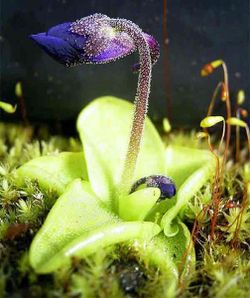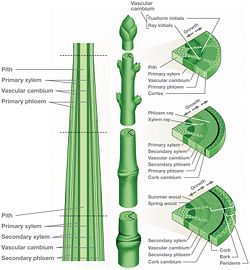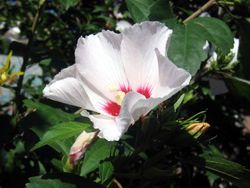Botany
2008/9 Schools Wikipedia Selection. Related subjects: Plants
Botany, plant science(s), phytology, or plant biology is a branch of biology and is the scientific study of plant life and development. Botany covers a wide range of scientific disciplines that study plants, algae, and fungi including: structure, growth, reproduction, metabolism, development, diseases, and chemical properties and evolutionary relationships between the different groups. The study of plants and botany began with tribal lore, used to identify edible, medicinal and poisonous plants, making botany one of the oldest sciences. From this ancient interest in plants, the scope of botany has increased to include the study of over 550,000 kinds or species of living organisms.
Scope and importance of botany
As with other life forms in biology, plant life can be studied from different perspectives, from the molecular, genetic and biochemical level through organelles, cells, tissues, organs, individuals, plant populations, and communities of plants. At each of these levels a botanist might be concerned with the classification ( taxonomy), structure ( anatomy and morphology), or function ( physiology) of plant life.
Historically, botany covered all organisms that were not considered to be animals. Some of these organisms are no longer considered to be part of the plant kingdom – these include fungi (studied in mycology), lichens ( lichenology), bacteria ( bacteriology), viruses ( virology) and single-celled algae, which are now grouped as part of the Protista. However, attention is still given to these groups by botanists, and fungi, lichens, bacteria and photosynthetic protists are usually covered in introductory botany courses.
The study of plants has importance for a number of reasons. Plants are a fundamental part of life on Earth. They generate the oxygen, food, fibres, fuel and medicine that allow higher life forms to exist. Plants also absorb carbon dioxide through photosynthesis, a minor greenhouse gas that in large amounts can affect global climate. It is believed that the evolution of plants has changed the global atmosphere of the earth early in the earth's history and paleobotanists study ancient plants in the fossil record. A good understanding of plants is crucial to the future of human societies as it allows us to:
- Produce food to feed an expanding population
- Understand fundamental life processes
- Produce medicine and materials to treat diseases and other ailments
- Understand environmental changes more clearly
Human nutrition

Virtually all foods eaten come from plants, either directly from staple foods and other fruit and vegetables, or indirectly through livestock or other animals, which rely on plants for their nutrition. Plants are the fundamental base of nearly all food chains because they use the energy from the sun and nutrients from the soil and atmosphere and convert them into a form that can be consumed and utilized by animals; this is what ecologists call the first trophic level. Botanists also study how plants produce food we can eat and how to increase yields and therefore their work is important in mankind's ability to feed the world and provide food security for future generations, for example through plant breeding. Botanists also study weeds, plants which are considered to be a nuisance in a particular location. Weeds are a considerable problem in agriculture, and botany provides some of the basic science used to understand how to minimize 'weed' impact in agriculture and native ecosystems. Ethnobotany is the study of the relationships between plants and people.
Fundamental life processes
Plants are convenient organisms in which fundamental life processes (like cell division and protein synthesis for example) can be studied, without the ethical dilemmas of studying animals or humans. The genetic laws of inheritance were discovered in this way by Gregor Mendel, who was studying the way pea shape is inherited. What Mendel learned from studying plants has had far reaching benefits outside of botany. Additionally, Barbara McClintock discovered ' jumping genes' by studying maize. These are a few examples that demonstrate how botanical research has an ongoing relevance to the understanding of fundamental biological processes.
Medicine and materials
Many medicinal and recreational drugs, like tetrahydrocannabinol, caffeine, and nicotine come directly from the plant kingdom. Others are simple derivatives of botanical natural products; for example aspirin is based on the pain killer salicylic acid which originally came from the bark of willow trees. There may be many novel cures for diseases provided by plants, waiting to be discovered. Popular stimulants like coffee, chocolate, tobacco, and tea also come from plants. Most alcoholic beverages come from fermenting plants such as barley (beer), rice ( saki) and grapes (wine).
Plants also provide us with many natural materials, such as cotton, wood, paper, linen, vegetable oils, some types of rope, and rubber. The production of silk would not be possible without the cultivation of the mulberry plant. Sugarcane, rapeseed, soy and other plants with a highly-fermentable sugar or oil content have recently been put to use as sources of biofuels, which are important alternatives to fossil fuels, see biodiesel.
Environmental changes
Plants can also help us understand changes in on our environment in many ways.
- Understanding habitat destruction and species extinction is dependent on an accurate and complete catalog of plant systematics and taxonomy.
- Plant responses to ultraviolet radiation can help us monitor problems like the ozone depletion.
- Analyzing pollen deposited by plants thousands or millions of years ago can help scientists to reconstruct past climates and predict future ones, an essential part of climate change research.
- Recording and analyzing the timing of plant life cycles are important parts of phenology used in climate-change research.
- Lichens, which are sensitive to atmospheric conditions, have been extensively used as pollution indicators.
In many different ways, plants can act a little like the ' miners canary', an early warning system alerting us to important changes in our environment. In addition to these practical and scientific reasons, plants are extremely valuable as recreation for millions of people who enjoy gardening, horticultural and culinary uses of plants every day.
History
Early botany
- Ancient India
Early examples of plant taxonomy occur in the Rigveda, that divides plants into Vrska (tree), Osadhi (herbs useful to humans) and Virudha (creepers). which are further subdivided. The Atharvaveda divides plants into eight classes, Visakha (spreading branches), Manjari (leaves with long clusters), Sthambini (bushy plants), Prastanavati (which expands); Ekasrnga (those with monopodial growth), Pratanavati (creeping plants), Amsumati (with many stalks), and Kandini (plants with knotty joints). The Taittiriya Samhita and classifies the plant kingdom into vrksa, vana and druma (trees), visakha (shrubs with spreading branches), sasa (herbs), amsumali (a spreading or deliquescent plant), vratati (climber), stambini (bushy plant), pratanavati (creeper), and alasala (those spreading on the ground).
Manusmriti proposed a classification of plants in eight major categories. Charaka Samhitā and Sushruta Samhita and the Vaisesikas also present an elaborate taxonomy.
Parashara, the author of Vrksayurveda (the science of life of trees), classifies plants into Dvimatrka ( Dicotyledons) and Ekamatrka ( Monocotyledons). These are further classified into Samiganiya ( Fabaceae), Puplikagalniya ( Rutaceae), Svastikaganiya ( Cruciferae), Tripuspaganiya ( Cucurbitaceae), Mallikaganiya ( Apocynaceae), and Kurcapuspaganiya ( Asteraceae).
Important medieval Indian works of plant physiology include the Prthviniraparyam of Udayana, Nyayavindutika of Dharmottara, Saddarsana-samuccaya of Gunaratna, and Upaskara of Sankaramisra.
- Ancient China
In ancient China, the recorded listing of different plants and herb concoctions for pharmaceutical purposes spans back to at least the Warring States (481 BC-221 BC). Many Chinese writers over the centuries contributed to the written knowledge of herbal pharmaceutics. There was the Han Dynasty (202 BC-220 AD) written work of the Huangdi Neijing and the famous pharmacologist Zhang Zhongjing of the 2nd century. There was also the 11th century scientists and statesmen Su Song and Shen Kuo, who compiled treatises on herbal medicine and included the use of mineralogy.
- Greco-Roman world
Among the earliest of botanical works in Europe, written around 300 B.C., are two large treatises by Theophrastus: On the History of Plants ( Historia Plantarum) and On the Causes of Plants. Together these books constitute the most important contribution to botanical science during antiquity and on into the Middle Ages. The Roman medical writer Dioscorides provides important evidence on Greek and Roman knowledge of medicinal plants.
Medieval botany
The Kurdish biologist Al-Dinawari (828-896) is considered the founder of Arabic botany for his Book of Plants, in which he described at least 637 plants and discussed plant evolution from its birth to its death, describing the phases of plant growth and the production of flowers and fruit.
In the early 13th century, the Andalusian-Arabian biologist Abu al-Abbas al-Nabati developed an early scientific method for botany, introducing empirical and experimental techniques in the testing, description and identification of numerous materia medica, and separating unverified reports from those supported by actual tests and observations. His student Ibn al-Baitar (d. 1248) wrote a pharmaceutical encyclopedia describing 1,400 plants, foods, and drugs, 300 of which were his own original discoveries. A Latin translation of his work was useful to European biologists and pharmacists in the 18th and 19th centuries.
Early modern botany
In 1665, using an early microscope, Robert Hooke discovered cells in cork, and a short time later in living plant tissue. The German Leonhart Fuchs, the Swiss Conrad von Gesner, and the British authors Nicholas Culpeper and John Gerard published herbals that gave information on the medicinal uses of plants.
In 1754 Carl von Linné (Carl Linnaeus) divided the plant Kingdom into 25 classes. One, the Cryptogamia, included all the plants with concealed reproductive parts (algae, fungi, mosses and liverworts and ferns).
Modern botany
A considerable amount of new knowledge today is being generated from studying model plants like Arabidopsis thaliana. This weedy species in the mustard family was one of the first plants to have its genome sequenced. The sequencing of the rice (Oryza sativa) genome and a large international research community have made rice the de facto cereal/ grass/ monocot model. Another grass species, Brachypodium distachyon is also emerging as an experimental model for understanding the genetic, cellular and molecular biology of temperate grasses. Other commercially-important staple foods like wheat, maize, barley, rye, pearl millet and soybean are also having their genomes sequenced. Some of these are challenging to sequence because they have more than two haploid (n) sets of chromosomes, a condition known as polyploidy, common in the plant kingdom. Chlamydomonas reinhardtii (a single-celled, green alga) is another plant model organism that has been extensively studied and provided important insights into cell biology.
In 1998 the Angiosperm Phylogeny Group published a phylogeny of flowering plants based on an analysis of DNA sequences from most families of flowering plants. As a result of this work, major questions such as which families represent the earliest branches in the genealogy of angiosperms are now understood. Investigating how plant species are related to each other allows botanists to better understand the process of evolution in plants.
Notable Botanists
- Ibn al-Baitar (d. 1248), Andalusian-Arab scientist, botanist, pharmacist, physician, and author of one of the largest botanical encyclopedias.
- Al-Dinawari (828-896), Kurdish botanist, historian, geographer, astronomer, mathematician, and founder of Arabic botany.
- Luther Burbank (1849-1926), American botanist, horticulturist, and a pioneer in agricultural science.
- Joseph Dalton Hooker (1817-1911), English botanist and explorer. Second winner of Darwin Medal.
- Thomas Henry Huxley (1825–1895), English biologist, known as "Darwin's Bulldog" for his advocacy of Charles Darwin's theory of evolution. Third winner of Darwin Medal.
- Carl Linnaeus (1707-1778), Swedish botanist, physician and zoologist who laid the foundations for the modern scheme of Binomial nomenclature. He is known as the father of modern taxonomy, and is also considered one of the fathers of modern ecology.
- Gregor Johann Mendel (1822-1884), Augustinian priest and scientist, and is often called the father of genetics for his study of the inheritance of traits in pea plants.
- Abu al-Abbas al-Nabati (c. 1200), Andalusian-Arab botanist and agricultural scientist, and a pioneer in experimental botany.
- Leonardo da Vinci (1452-1519), Italian polymath; a scientist, mathematician, engineer, inventor, anatomist, painter, sculptor, architect, botanist, musician and writer.




